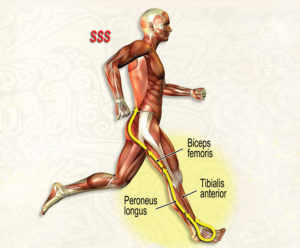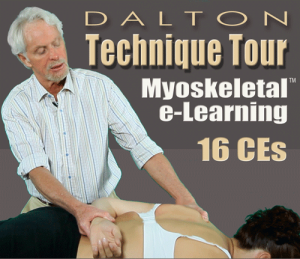All too often, the notion of earning massage CEs may be thought of in the context of renewing and maintaining one’s license to practice. However, investing time and money in massage CEs can actually have a lasting effect on the career of a professional massage therapist or bodyworker. By selecting the right classes, you can find a way to not only maintain your massage certification, but also provide your clients with more valuable services, increase your income on a consistent basis and find deeper satisfaction in your daily work as a manual therapist.
These may seem like lofty goals when it comes to the simple act of earning massage CEs, but when you are able to find a skilled educator and a thorough course that has been designed well, it is possible to begin achieving these very goals and more. Here, we will provide a brief introduction to the work of educator and practitioner Erik Dalton, who is the creator of Myoskeletal Alignment Techniques (MAT). Dalton has developed a catalog of programs that take place both in person and via remote learning methods, giving massage therapists and bodyworkers all over the world the opportunity to earn massage CEs and take their careers to the next level by completing these classes.
The first question many folks may ask is this: What is myoskeletal alignment therapy? Of course, if you are considering using your upcoming massage CEs as a route toward learning more about MAT, this question is a great place to begin. Myoskeletal alignment therapy is a modality that Dalton created out of his own rich experience and education in a wide variety of relevant topics, such as Rolfing® and manipulative osteopathic approaches to pain management that stem from scientific research. In fact, Dalton counts Ida P. Rolf, Philip Greenman, DO, and Vladimir Janda, MD, among his primary influences in the development of MAT.
One of the main premises of MAT is that the body’s myofascial and skeletal systems are inseparable, and what affects one always affects the other. Therefore, the primary focus of MAT is the treatment of stubborn pain conditions via the hands-on process of mobilizing joints through muscle manipulation. Learning these breakthrough approaches to the common and not-so-common issues and conditions that your clients present can be the foundation of creating a highly successful practice. Those who enroll to earn massage CEs through one of Dalton’s in-person seminars or remote learning programs will quickly see how these deep tissue massage techniques can take one’s career toward the lucrative and rewarding realm of orthopedic massage and medical massage.
Along with earning any necessary massage CEs, manual therapists who sign up for an on-site class or remote learning program developed by Dalton and his team can expect to learn a vast array of much-needed skills and techniques, from efficient assessment methods to special Myoskeletal Receptor Techniques that can help break neurological pain cycles. Among the other areas of focus for MAT classes are how to assess and correct muscle imbalance patterns; how to safely integrate Golgi tendon, ligament friction, facet recoil, assisted stretching and muscle spindle techniques; how to treat dural drag at the occiput, C2 and coccyx; and much more.
MAT also teaches manual therapists six dynamic ways to identify and correct conditions such as sciatica, lumbago, scoliosis, dowager’s hump, rib dysfunction, carpal tunnel, rotator cuff injuries, forward head postures and thoracic outlet syndrome, among other issues and conditions. It is not difficult to see how possessing such skills could be a huge boon to one’s practice and regular income, via more satisfied clients, longer-lasting results, better word of mouth and increased referrals from other health care practitioners, such as medical doctors, chiropractors and physical therapists.
In the end, MAT serves as a modality that can help you take your clients to a new and improved level of health, by finally providing them with relief from their pain—and doing so in a way that does not involve prescription pain medicine or invasive surgery. Even for those clients who have had to undergo surgery and take medication for their pain, a skilled MAT practitioner may be able to ease and enhance the process of rehabilitation.
Whether you just received your massage certification or are simply pondering a career in the field of professional massage therapy and bodywork, you may be on a quest to explore the different facets of this broad industry. For those who only recently graduated from a manual therapy school, the question of what is myoskeletal alignment therapy may be one you are asking as you consider a more specialized direction for your career. If you are wondering about Myoskeletal Alignment Techniques (MAT), which is another name for myoskeletal alignment therapy, prior to enrolling in your massage education, then you may be getting a head start in shaping a touch therapy career that is directed more toward medical massage than the relaxation model of massage that is taught in so many schools.
In order to find out exactly what is myoskeletal alignment therapy, the place to begin is not secondary sources but with the creator of MAT, Erik Dalton. Founder of the Freedom From Pain Institute in Oklahoma City, Oklahoma, Dalton developed this rich, well-researched and thoroughly tested tool box of deep tissue massage techniques in an effort to help people better manage and alleviate all kinds of pain, particularly the stubborn pain patterns that tend to affect people for long periods of time and, in turn, take a toll on their quality of life. For example, MAT comprises specific massage techniques for back pain that can assist clients in gaining relief from this all too common and powerful type of pain.
As you look further into the question of what is myoskeletal alignment therapy, you will find that relief from back pain is just one in a long line of potential benefits that MAT can bring for client issues and conditions of all kinds. Among the many other scenarios Dalton has developed MAT techniques to address are sciatica, lumbago, scoliosis, dowager’s hump, rib dysfunction, carpal tunnel syndrome, rotator cuff injuries, forward head postures and thoracic outlet syndrome, to name a few. These breakthrough therapeutic approaches aim to treat soft tissue pain that spans the spectrum of conditions. MAT works to address these persistent pain patterns by mobilizing joints through muscle manipulation.
Of course, an answer to an inquiry that asks what is myoskeletal alignment therapy could not be complete without at least mentioning the fact that MAT also encompasses effective methods for assessing clients. A thorough and proper evaluation structure is crucial for the manual therapist who hopes to achieve results. After all, if one cannot identify or at least form a reasonable hypothesis or two for what is causing the client’s pain, it will be tough to bring any lasting relief. It is important for the professional massage therapist or bodyworker who practices MAT to be able to feel confident in finding the true source of the issue or condition, rather than be distracted by flashy symptoms that lead the therapist in the direction of temporary, rather than long term, solutions.
In order to continue gaining a better understanding of what is myoskeletal alignment therapy, it may be helpful to consider the contexts in which MAT may be used. This signature modality exists toward the more clinical end of the manual therapy spectrum. For example, many practitioners may choose to focus their education on MAT to build a practice that centers on massage for sports therapy or orthopedic massage. These folks may end up opening their own independent clinics or go to work for hospitals, physical therapists, chiropractors, orthopedic doctors and other medical professionals. The common thread for the MAT practitioner tends to be the nature of the clients who are coming in, whether on their own or through medical referrals. In general, these are going to be clients who are significantly motivated to find relief from their pain, often after exhausting several other avenues of both traditional and complementary care.
While this article provides only a small glimpse of an answer to the question what is myoskeletal alignment therapy, a tour through Erik Dalton’s extensive website or a look at his continuing education offerings should deliver a deeper understanding of MAT and its importance in the realm of manual therapy for pain management.
Click here for more information.
On sale this week only!
Save 25% off the "Dalton Technique Treasures" eCourse
The “Dalton Technique Treasures” eLearning course is a compilation of some of Erik’s favorite Myoskeletal Alignment Techniques (MAT). Learn MAT techniques to assess and address specific sports injuries, structural misalignment, nervous system overload, and overuse conditions. ON SALE UNTIL July 29th! Get Lifetime Access: As in all our eLearning courses, you get easy access to the course online and there is no expiry date.






